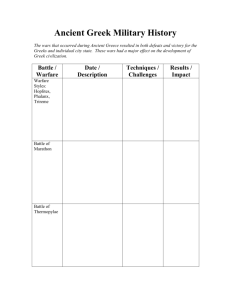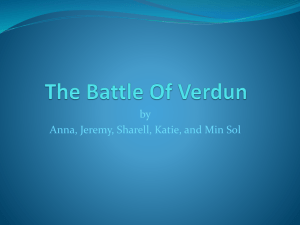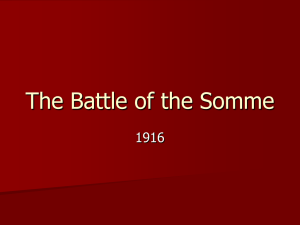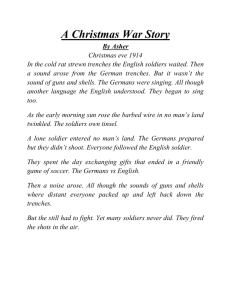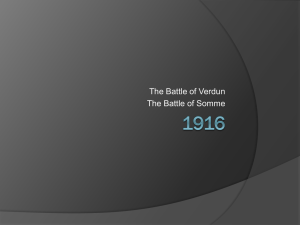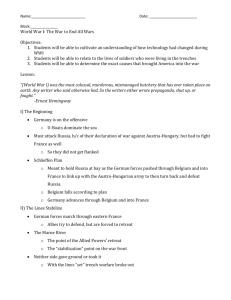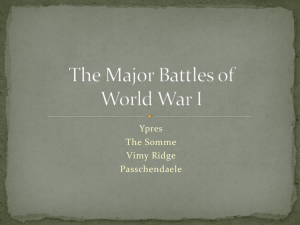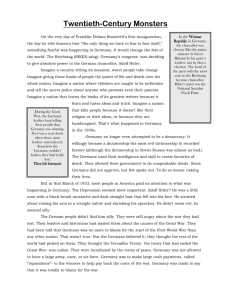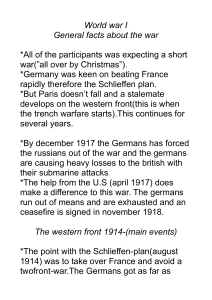World War One_ III. War in Europe_D. to F.
advertisement
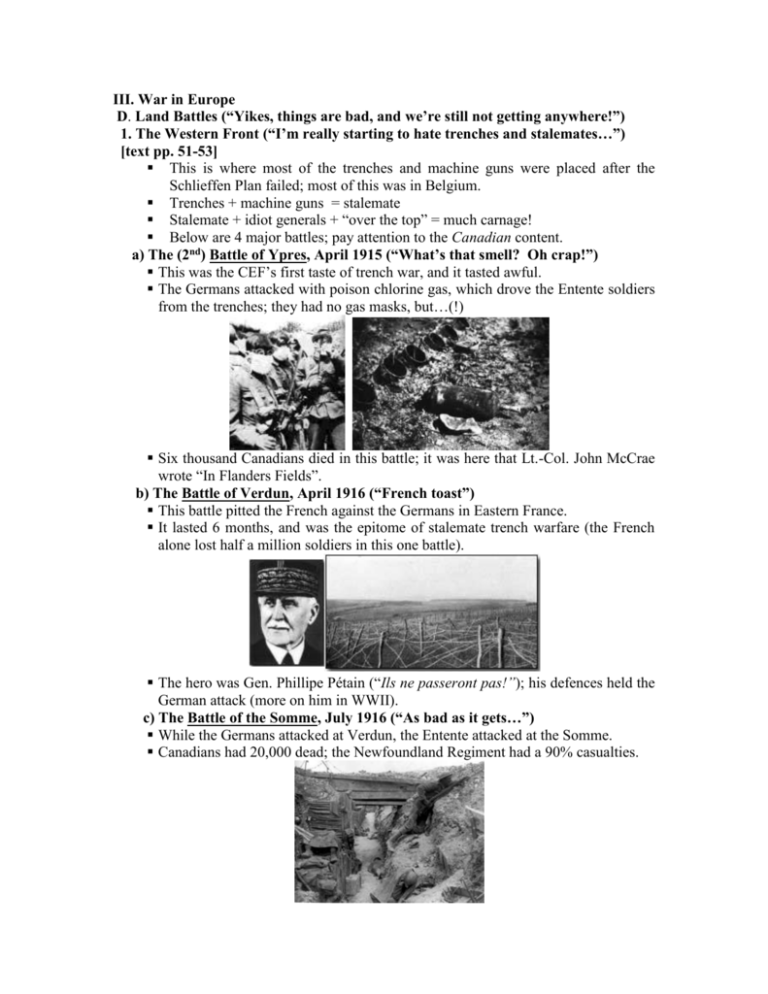
III. War in Europe D. Land Battles (“Yikes, things are bad, and we’re still not getting anywhere!”) 1. The Western Front (“I’m really starting to hate trenches and stalemates…”) [text pp. 51-53] This is where most of the trenches and machine guns were placed after the Schlieffen Plan failed; most of this was in Belgium. Trenches + machine guns = stalemate Stalemate + idiot generals + “over the top” = much carnage! Below are 4 major battles; pay attention to the Canadian content. a) The (2nd) Battle of Ypres, April 1915 (“What’s that smell? Oh crap!”) This was the CEF’s first taste of trench war, and it tasted awful. The Germans attacked with poison chlorine gas, which drove the Entente soldiers from the trenches; they had no gas masks, but…(!) Six thousand Canadians died in this battle; it was here that Lt.-Col. John McCrae wrote “In Flanders Fields”. b) The Battle of Verdun, April 1916 (“French toast”) This battle pitted the French against the Germans in Eastern France. It lasted 6 months, and was the epitome of stalemate trench warfare (the French alone lost half a million soldiers in this one battle). The hero was Gen. Phillipe Pétain (“Ils ne passeront pas!”); his defences held the German attack (more on him in WWII). c) The Battle of the Somme, July 1916 (“As bad as it gets…”) While the Germans attacked at Verdun, the Entente attacked at the Somme. Canadians had 20,000 dead; the Newfoundland Regiment had a 90% casualties. Total casualty rate for this 5 month battle was 1.25 million men! Look at p. 52 for the 7 reasons your text says why the Battle of the Somme was a disaster, especially #7 (shell shock and firing squad). d) The Battle of Vimy Ridge, April 1917 (“We’re #1! This time we mean it!”) Read this bit on page 53; it’s Canada’s shining moment in the war. Vimy Ridge was in German control; 150,000 British and French had already died trying to take it. The CEF managed to take it, suffering 3,000 dead, but they did it as their own independent unit instead as part of the British. Canadian Gen. Arthur Currie was now given command over the CEF. e) The Battle of Passchendaele, October 1917 (“Smoke on the water…and mud…and blood…and body parts…”) Entente High Command wanted the CEF to take the town of Passchendaele. Currie advised against it because of the mud, but he was over-ruled. The Canadians managed to take and hold the town, but they lost 16,000 dead. In the end, they only gained 7 km, and the Germans took it back eventually. 2. The Eastern Front [text pp. 53-54] a) The Russian Campaign, 1914-1916 (“No borscht for you! Next!”) The Germans had more success helping Austria-Hungary fight the Russians. They were able to contain the Russians (until 1917 when the Russian Revolution started), but the troops they used here prevented them from breaking the stalemate on the Western Front. b) Gallipoli, April-December, 1915 (“Is it time to eat breakfast?”) This was the only clever attempt to break the stalemate. Gallipoli was very strategic (read p. 54 to find out why). The Ottoman Empire (Turkey) joined the Central Powers to prevent Russia from getting a sea-port in the Balkans. Most of the troops were ANZACs (Australian and New Zealand troops). At one point, the ANZAC had a chance to breach the Turkish line, but the commander inexplicably ordered his men to stop for breakfast! This gave the Turkish commander a chance to reinforce his troops and stop the advance. This turned into another wasteful stalemate. E. War in the Air (“Where the real manly men were…”) [text p. 54] 1. Canadians in the air The airplane was only invented in 1903, but by WWI, both sides had an air force. The Germans had an advantage in air power over the British. Canadians flew with the RAF; by 1918, Canadians were 40% of the RAF. 2. Fighting Techniques At first, planes were for reconnaissance. Later, they were used to drop bombs or fire pistols. Then, machine guns were designed on these planes, and this started aerial duels called dogfights. 3. Role of the Pilot Pilots were the most romanticized “manly” of men of WWI. The top two in WWI were the German Baron Erick von Richthofen (the Red Baron) and Canadian Billy Bishop. The life expectancy of a pilot was three weeks. F. War at Sea 1. Command of the Sea The British had naval superiority, and they blockaded German ports, so the Germans resorted to a new weapon. 2. The U-Boats (“We all live in a yellow submarine…”) U-boats were submarines, and the Germans used them to attack British military ships, but also ships transporting goods to and from Britain. German High Command advocated “unrestricted submarine warfare”, meaning that they would attack any ship helping the Allies, including non-military ships. a) The Lusitania (“You thought the Titanic was bad…at least no Celine Dion.”) In 1915, German U-Boats sunk the Lusitania, a British passenger ship. Almost 1200 people died, including 128 Americans. b) The U-Boat threat (“I’ll sub you good!”) This proved that the U-Boat threat was real, and the British were anxious. Supplies were low in Britain, and they depended on the supplies they got through maritime shipping. c) Convoy System (“You can’t sink us all.”) The British defense was the use of convoys; supply ships were escorted by military ships; this allowed supplies to reach Britain and neutralize the U-Boats. 3. The U.S. enters the war (It’s about bloody time, Yank!”) a) The Lusitania The 128 dead Americans happened to be influential, and their families pressured President Woodrow Wilson to enter the war. b) Unrestricted submarine warfare. News of German intentions to continue with unrestricted submarine warfare increased this pressure. c) The Zimmermann Telegram (“I’ll throw in a free burrito with it.”) This is what really pushed the U.S. over the edge. In 1917, German Foreign Minister Arthur Zimmermann cabled the Mexican government promising support if Mexico attacked the U.S. Britain intercepted this telegram and gave it to Wilson, who published it. The U.S. promptly declared war on Germany Assignment 1) “Even though Canada became its own nation in 1867, it wasn’t really independent until 1916.” Explain why you agree or disagree with this statement. 2) Was it a good idea for the Germans to use unrestricted submarine warfare. Explain why or why not.
